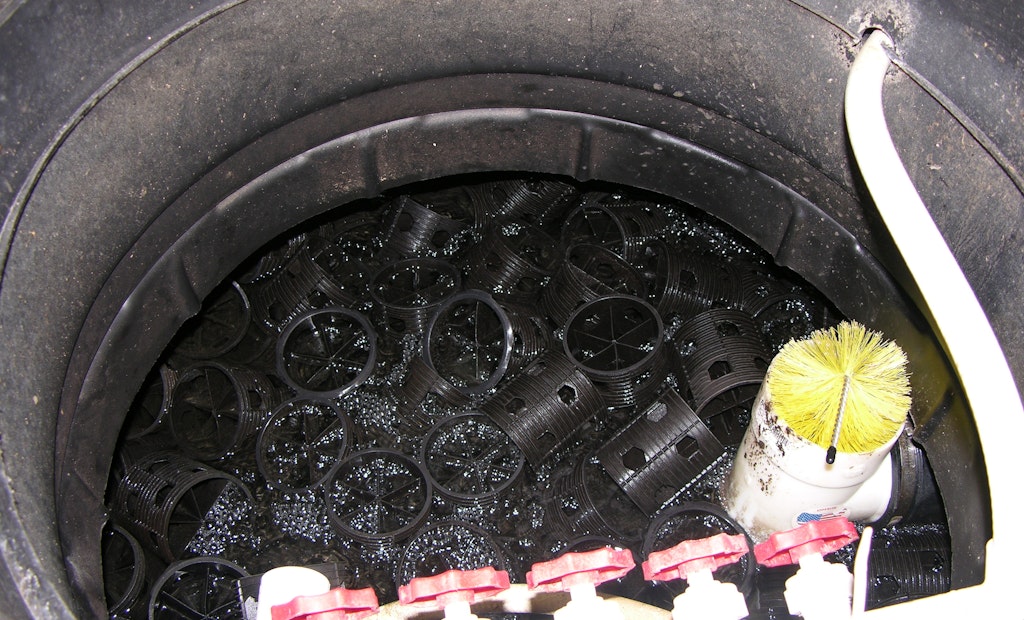Interested in Education/Training?
Get Education/Training articles, news and videos right in your inbox! Sign up now.
Education/Training + Get AlertsAs a service provider, it’s important to know what type of ATU you are dealing with. The unit types are: suspended growth, sequencing batch reactor, attached or submerged growth/fixed media process, and rotating biological contractor.
In a suspended growth system the microbes are free-swimming and moving around in the water within the aeration chamber. Air entering the system assists in mixing the microbes with the food entering the aeration chamber.
Sequencing batch reactors use a suspended growth process for wastewater treatment where all of the functions are performed in the same treatment tank. When wastewater enters the treatment tank, the aeration system is turned on to facilitate aerobic treatment. The air entry can also facilitate mixing in the tank. After aeration, the air pump is turned off and the suspended growth materials are allowed to settle. The clarified effluent is decanted or pumped out of the tank. The chamber is allowed to sit idle for a short period of time to facilitate development of anoxic conditions to facilitate denitrification. The sequencing batch reactor may have a pretreatment tank for collecting the wastewater from the home as it waits to be dosed into the treatment reactor.
In an attached or submerged growth unit, wastewater flows from a trash tank into the aeration tank where air is introduced. The aeration tank also contains the media, usually plastic disks of differing designs, which serve as the home for the microbes. Treated wastewater passes into the clarifier. The use of a clarifier may be limited in some attached growth systems. The settled solids /effluent can be returned to either the aeration chamber or the septic/trash tank depending on the treatment arrangement.
Submerged media allow the microbes to be attached in the saturated condition. These media are generally made of plastic and must allow water and sloughing biomass to pass through them. Microbes grow on the surface of the media. The microbes will remove the food (waste) from the wastewater as it flows past. Effluent is circulated through the media thus passing contaminants by the microbes using rising air from diffusers in the bottom of the tank or a mechanically induced aeration system such as an aspirator.
The system is also operated in a condition where there is excess oxygen to promote microbial growth. Since the food supply is limited, the microbes are not only eating the waste in the water but are also eating the other microbes. This process limits the amount of biomass that is generated in the treatment process and thus the amount of residuals or sludge that need to be pumped from the system.
Rotating biological contactors use a submerged treatment process with a little different twist. An air space is used for aeration of the wastewater rather than an air pump to force air into the wastewater. So the air space at the top of the system is open and the oxygen is supplied from the air as the rotating media pass through the space.
A fixed film media disk is attached to a shaft extending through the system. The microbes are attached to this round media disk to facilitate maximum surface area for the available rotating space.
A motor is attached to the shaft and slowly moves the disks in a circular motion. The lower part of the disk is submerged in the wastewater. As the microbes attached to media are submerged in the wastewater the contaminants are adsorbed to the surface of the microbes. The upper portion of the disk passes through the air in the upper portion of the chamber. Oxygen moves from the air into the thin film of water that is attached to the surface of the microbes growing on the disk.
About the Author
Jim Anderson is connected with the University of Minnesota onsite wastewater treatment education program, is an emeritus professor in the university’s Department of Soil Water and Climate, and education coordinator for the National Association of Wastewater Technicians. Send him questions about septic system maintenance and operation by email to kim.peterson@colepublishing.com.
This article is part of a series on ATUs:
- An Introduction to ATUs
- Wastewater Loads and the ATU
- How Well Do You Know Your ATUs?
- ATU Components You Should Know
- ATU Inspection in 3 Easy Steps






